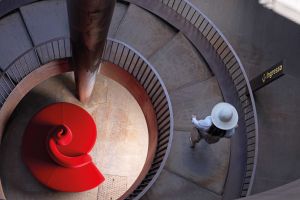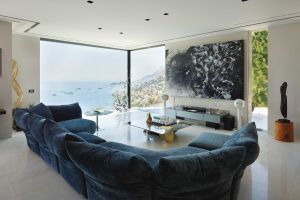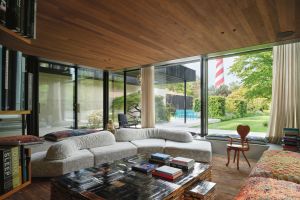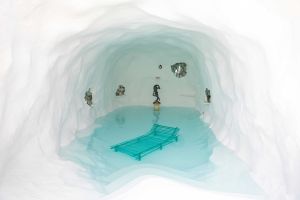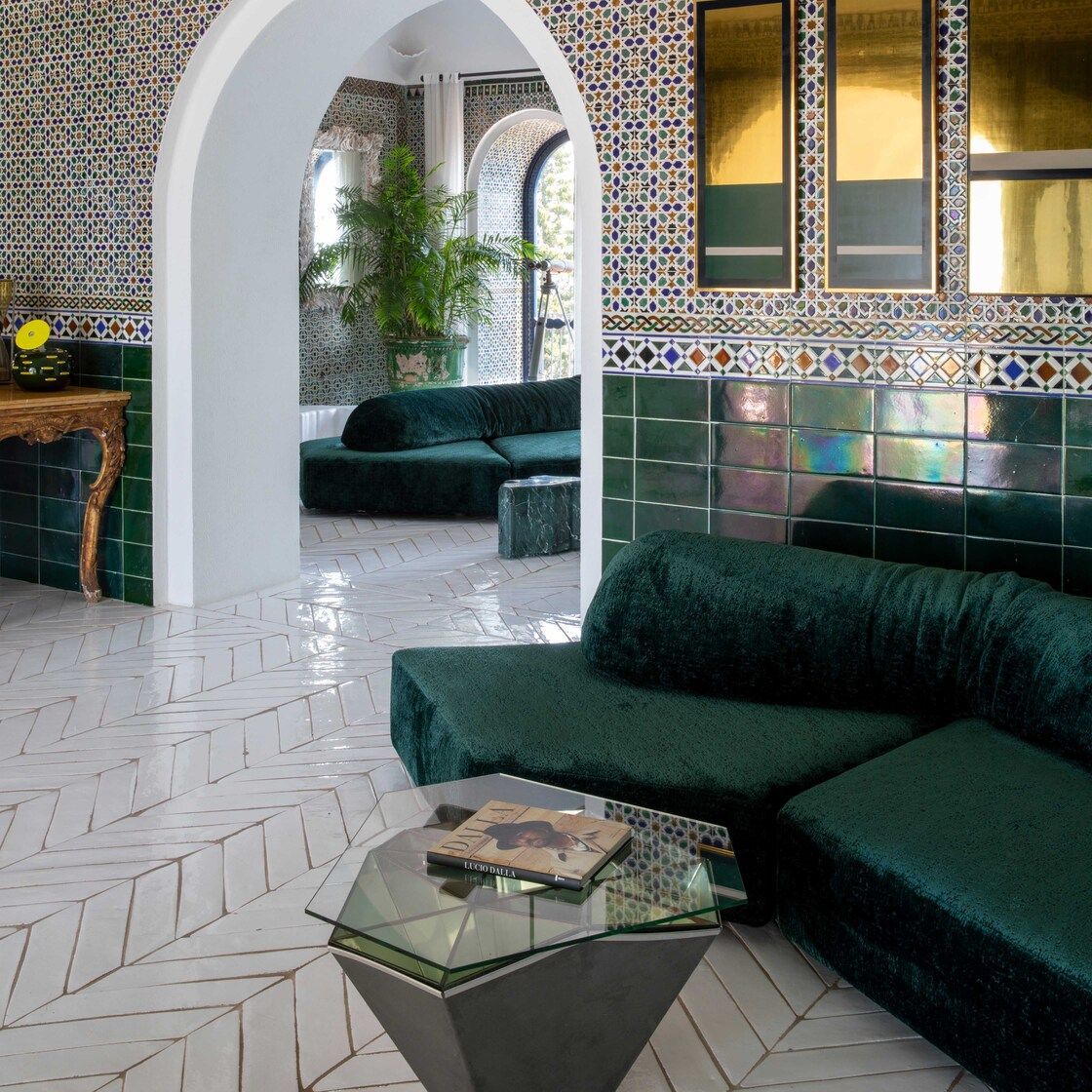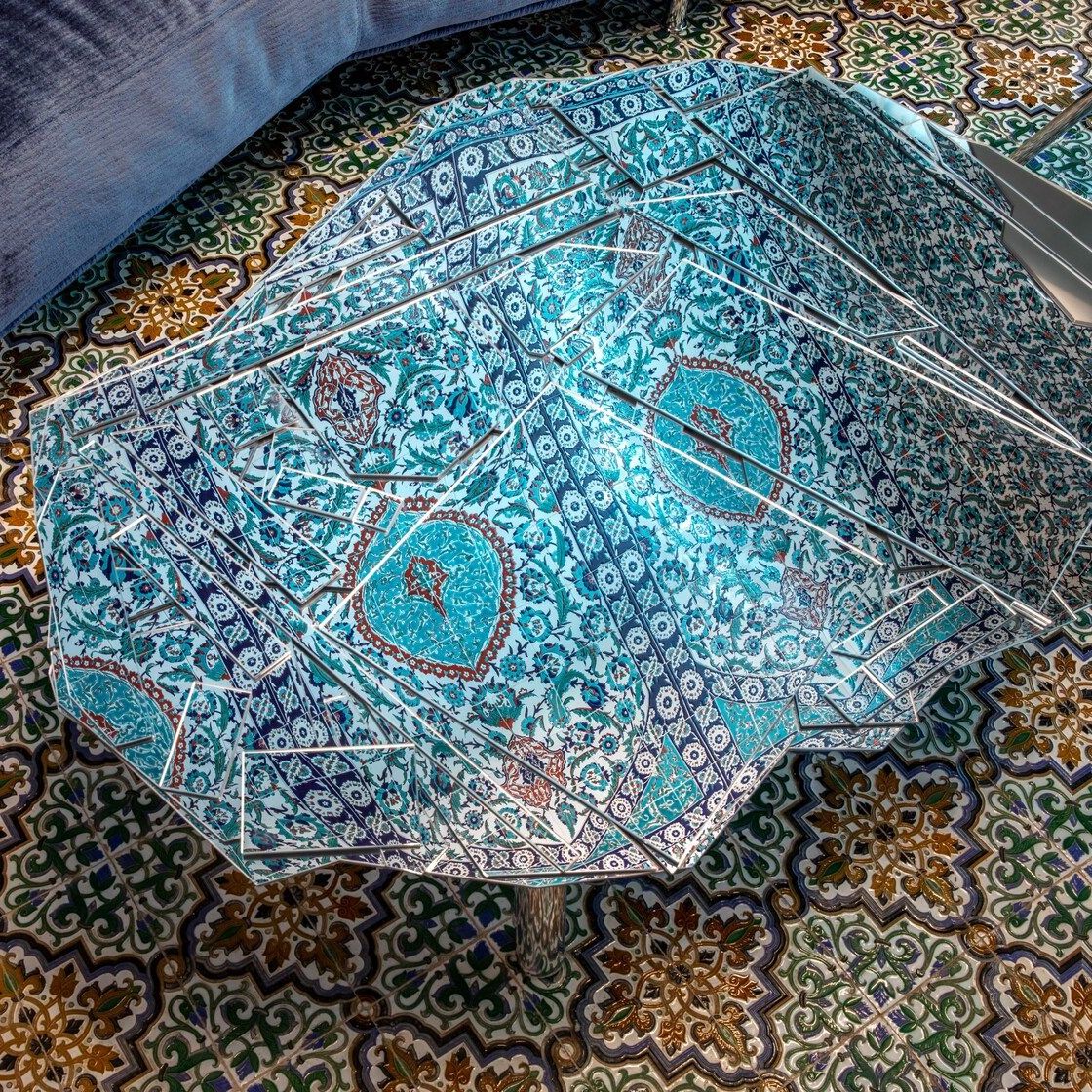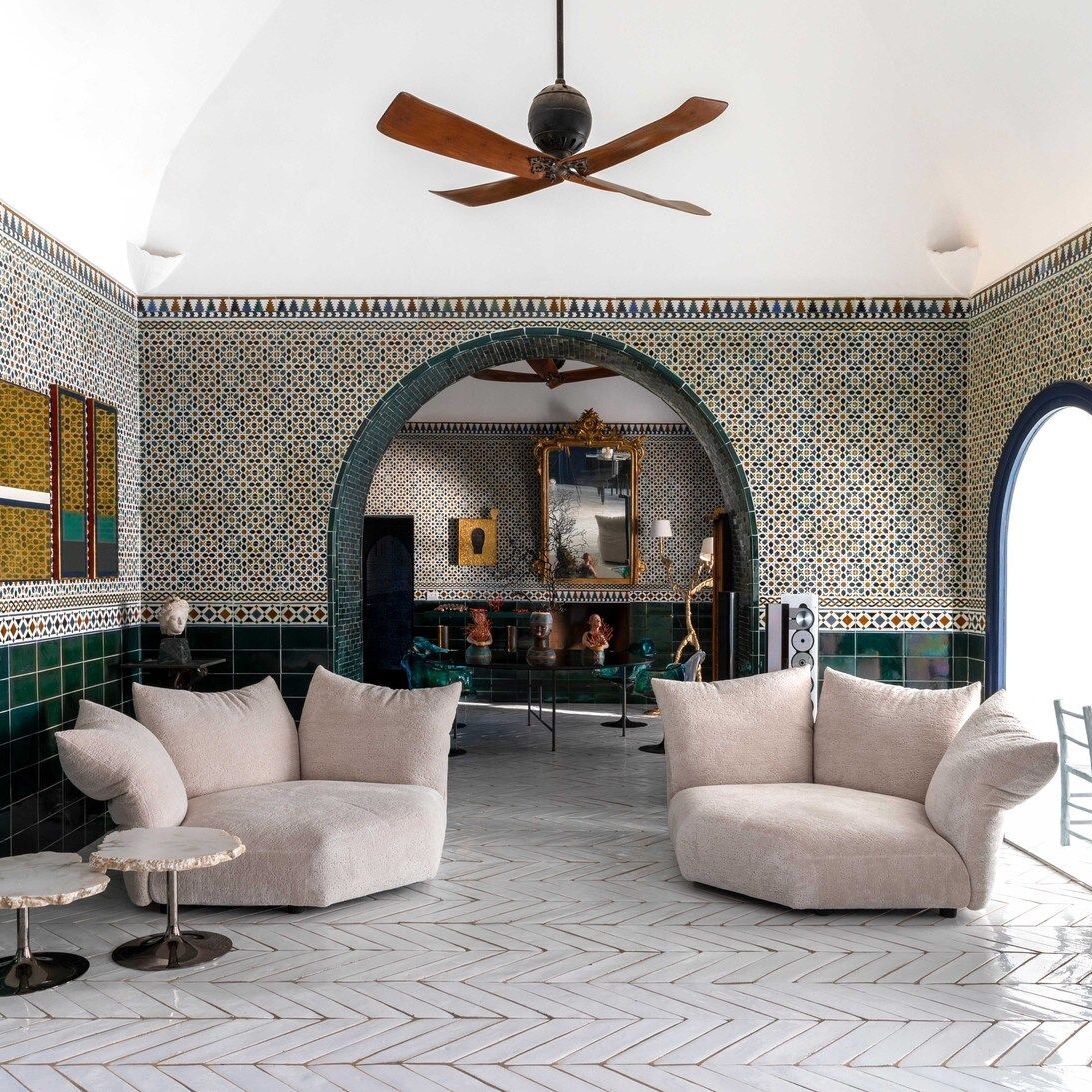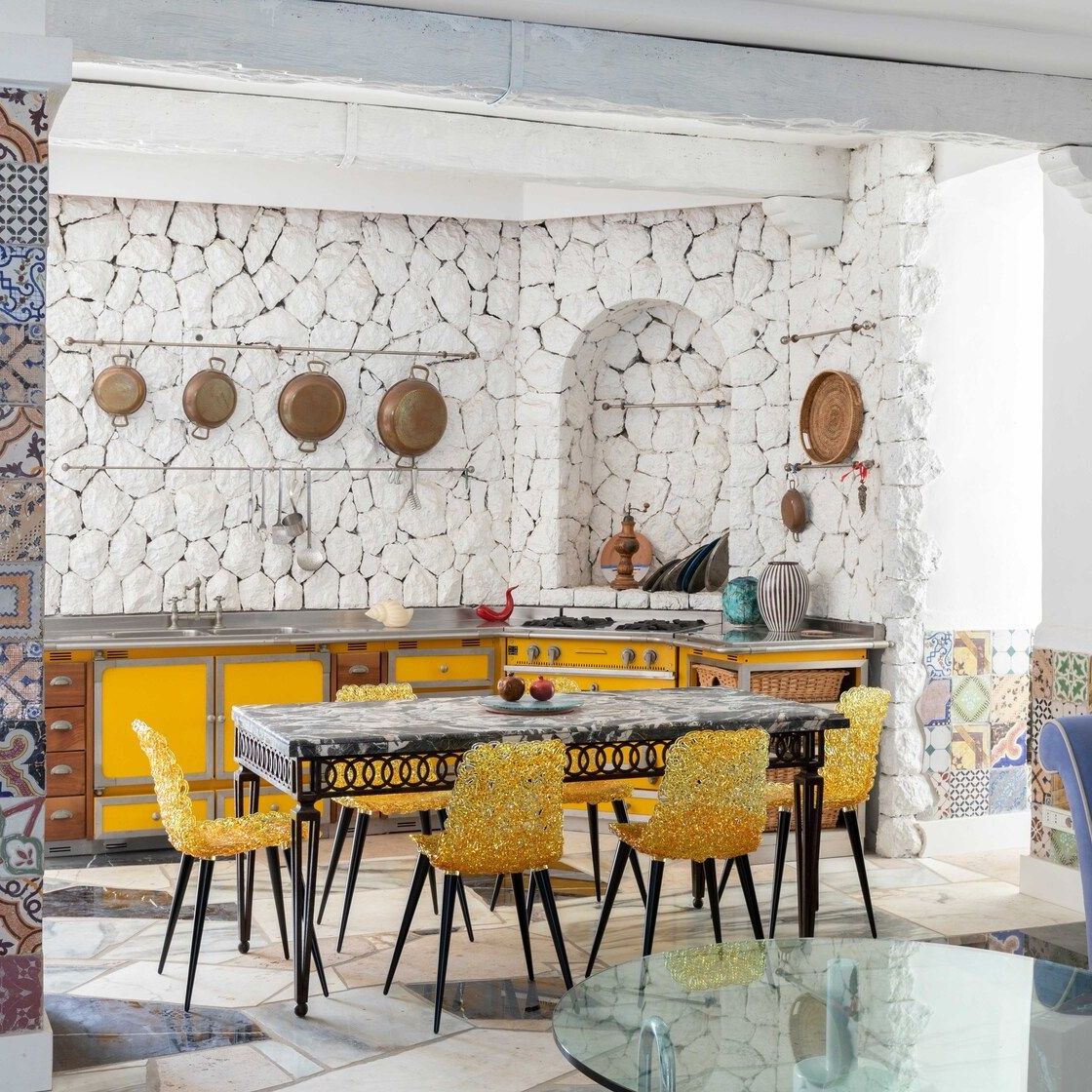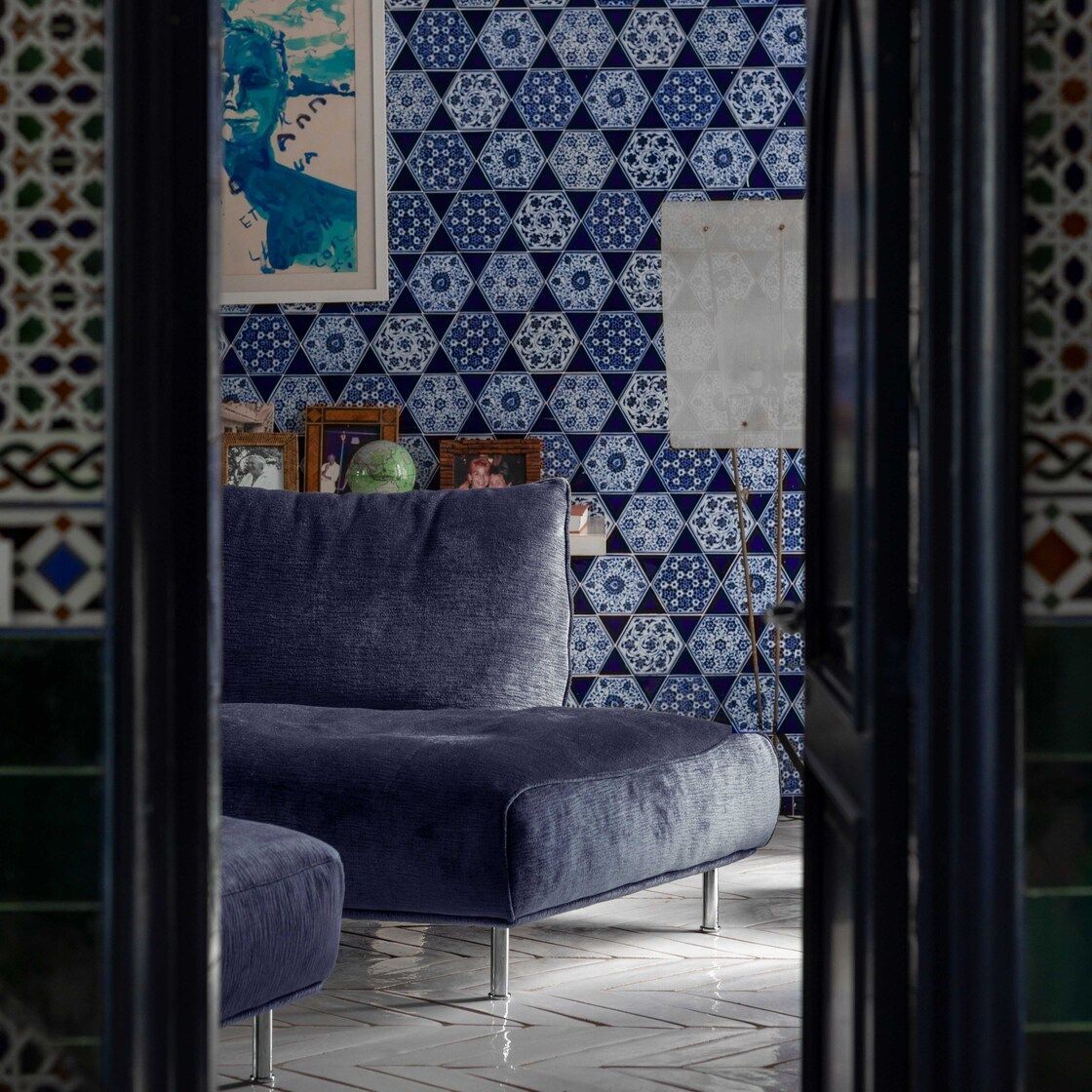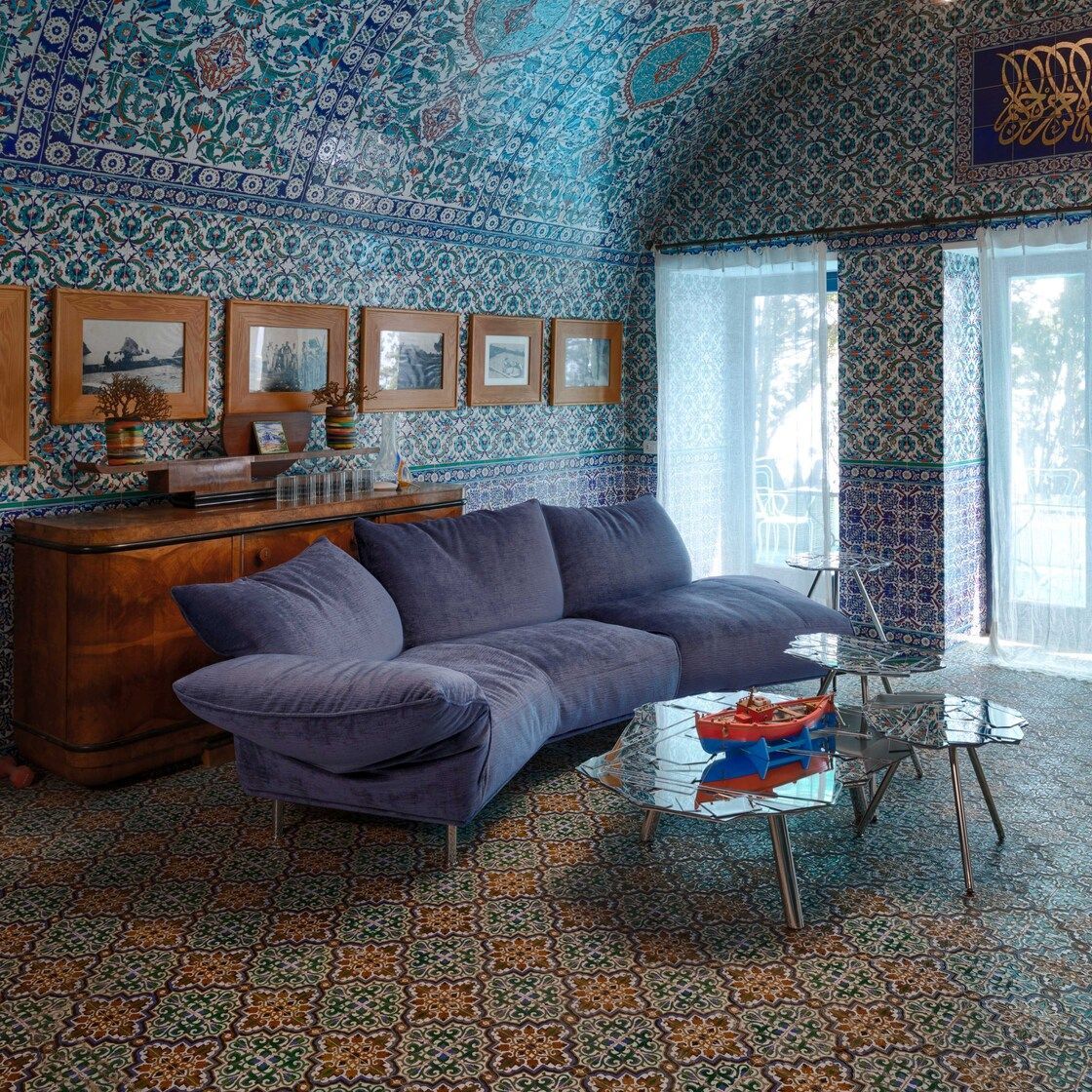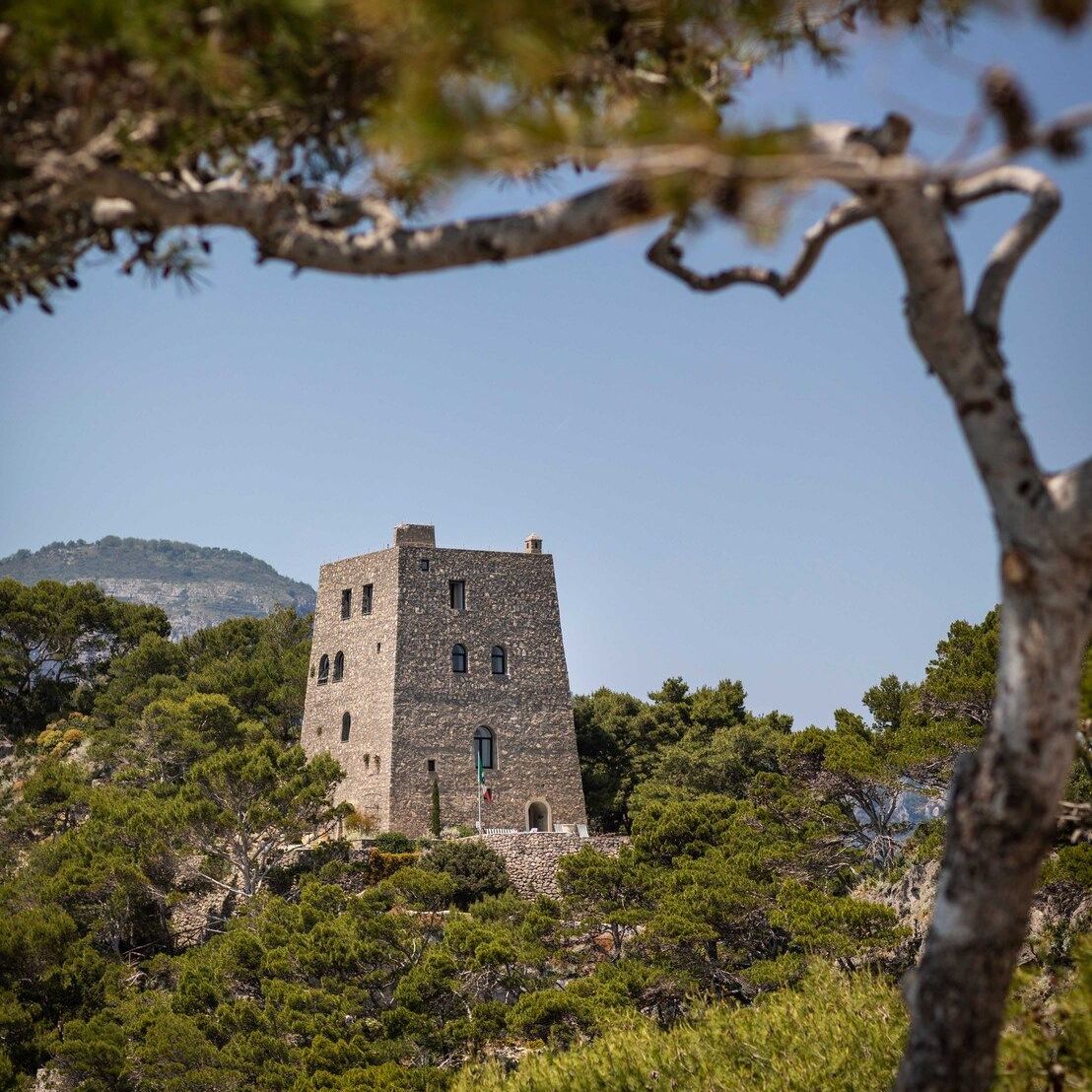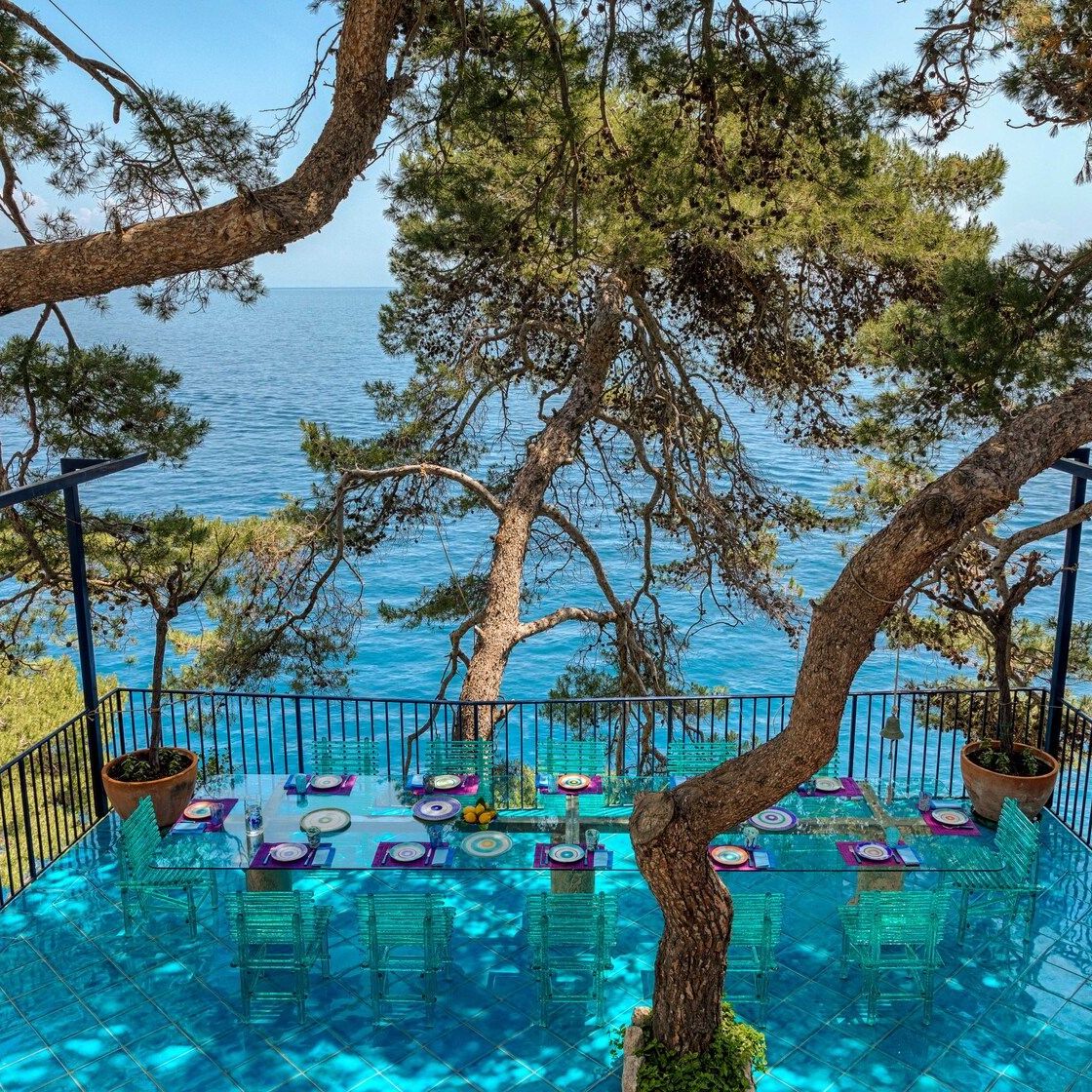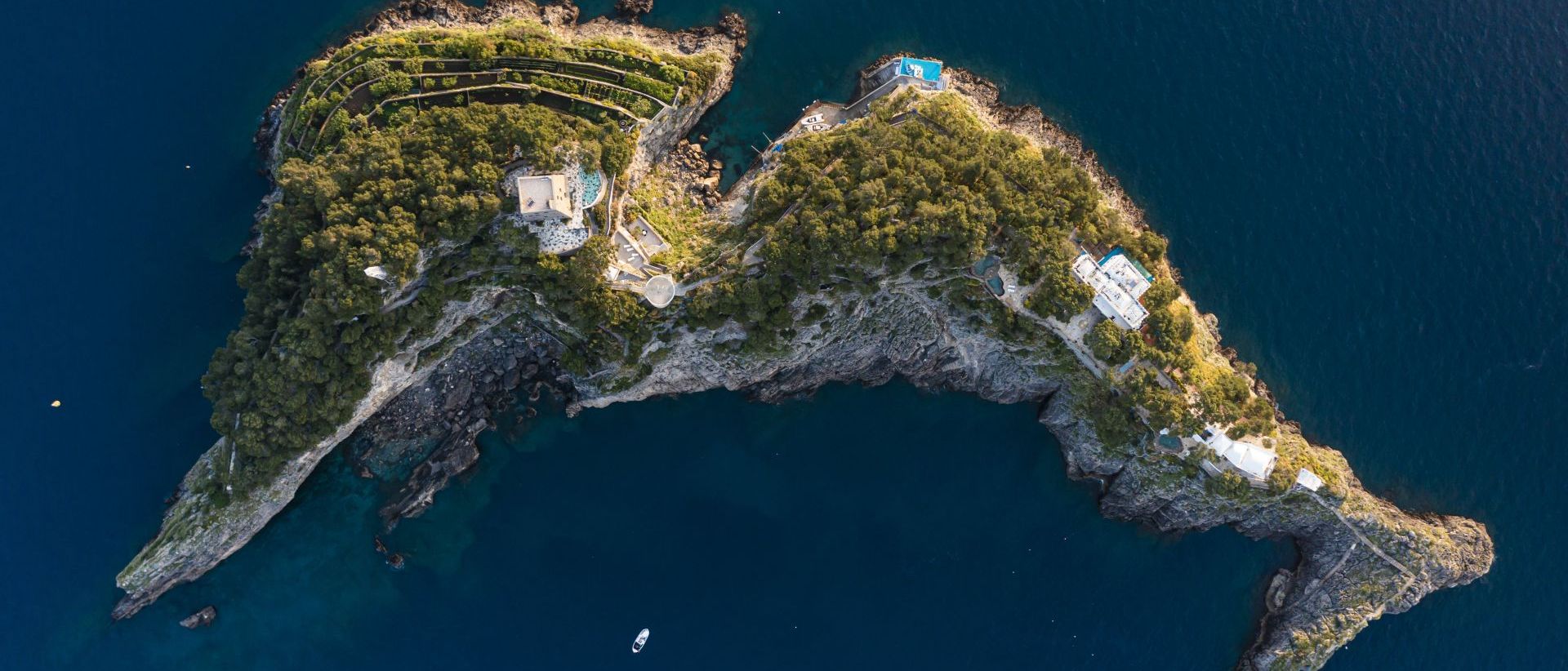
The Li Galli archipelago. Aerial view of the three islets called Gallo Lungo, the largest, with the silhouette of a dolphin, La Rotonda and La Castelluccia.
November 2022
Laura Arrighi
Li Galli, The Island of the Sirens
An archipelago where furniture, art and nature coexist.
Neverland does indeed exist. It is off the coast of Positano. From it, you can see Capri. It is home to ballet dancers enraptured by sirens’ songs. Writers who weave stories from an eternal time. Architects who design shelters for the soul. If you walk along the alleyways, you will not meet them. They are from a different era, although theirs is an era that has never come to an end. But they are there, inside what you see, what you do, and what you think.
Siren Island
Off the coast of Positano, halfway to the island of Capri, lies the small archipelago called “Li Galli”. It consists of three islets called “Gallo Lungo”, which is the largest and is shaped like a dolphin, “La Rotonda”, and “La Castelluccia”, also known as the “Isola dei Briganti”, or Bandit Island, from the pirates who once lived there. It is the month of May as I approach the archipelago. A magical place is in front of me. Sunlight filters through the clouds creating shadows on the promontory, which slopes rapidly down to the sea. The waves break on the bedrock. At the top, thick maritime pines conceal mystery. In this wild, natural setting, you can see a docking place and a “path” marked with dry stone walls that zig-zag upwards. It is an invitation to land. I understand why these three islets are also known as “The Sirens ”. The siren song is evidently a metaphor, but the call of the island, which encourages discovery, is real. The name refers to the myth of the Sirens narrated by Homer in Book XII of the Odyssey. When Odysseus tells King Alcinous how, having been informed by Circe of his impending encounter with the Mermaids who lived in the archipelago and of the danger inherent in listening to their song, he manages to avoid their trap with a stratagem. Although the image of Sirens as beings with a fish’s body and a woman’s head is present in Ancient Greece, a more “earthy” version of this figure is recurrent in mythology. In the Argonautica told by Apollonius Rhodius, when Orpheus arrived near Antemoessa, the island of the Sirens, he saw beings “similar to maidens in their bodies and partly similar to birds”. Women with rooster heads. This is the reason for the name.
The Island of Dance.
I start to walk up the path through lush, well-kept nature: a riot of colours and scents among flowers, succulents and wild vegetation. Small rooster-shaped statues rest on the dry stone walls. I catch a glimpse of some busy people. Gardeners are pruning, others are cleaning the path. Someone is tending a vegetable garden. A boy comes down the hill with a beehive in his hand and offers me freshly harvested honey. The island is inhabited and full of life. I look up and see an old, restored Saracen tower. Finally, I reach a villa that stands on the ashes of an ancient Roman Domus. Traces of history emerge and others remain hidden, preserved like indelible tattoos of this land. In front of the villa, the island’s current owner, Giovanni Russo Li Galli, greets me with a smile. In a white linen suit, barefoot, with a dachshund named Gordon in tow, he opens his arms: “Welcome.” His gaze is gentle, like his manner. He tells me that he sees himself as a guest of the island. He has the honour of living on it and taking care of it. Slowly, the sun also comes out. I set off to discover Li Galli with Giovanni and Pietro, the current “custodian,” who takes care of the archipelago’s maintenance. They tell me the story of someone who, captivated by the island’s beauty could no longer leave it once he landed. The main villa dates back to the 1920s, when - invited by Russian writer Mikhail Nikolaevič Semenoff - Russian ballet dancer and choreographer Leonid Fedorovič Mjasin (Léonide Massine) came to Italy with Picasso, bought the island and moved there. His intention was to create an artistic centre for music, dance and culture. At that time on the island, there were the remains of a Saracen tower, an ancient Roman villa, a cistern and a docking place, and an old shelter at the top of the small bay facing the mainland. Remains of medieval structures and older ruins were found on Isola dei Briganti. The summer of 1924 saw the start of a series of landscaping and architectural renovations. In The Siren Isles, Li Galli, Romolo Ercolino recounts that for the design of his villa, Massine contacted his friend and architect Le Corbusier, who came to Positano as a guest at Li Galli.
There seems to be a link between certain type of islands and dreams. Or maybe the fact is that islands of this kind attract dreamers.
Le Corbusier also visited Capri and was fascinated by Capri’s spontaneous architecture. To this, he dedicated an article in “Domus” in October 1937 in which he explained how there are multiple definitions of architecture, the most expressive of which is: “The construction of a shelter. If the body, heart and thought are sheltered, no restrictions limit this programme: it can be envisaged without boundaries. It can become a miraculously orchestrated symphony; it can also constrain itself or attain the form of a pure song. [...] The works of folklore require no justification: they speak. [...] The house is a reflection of spirit. It is what we are or want to be. [...] Its ways come from the best layers of things, nature and man.” With this eulogy of “pure”, simple, spontaneous architecture, the Lecorbusian text emphasises aspects we also recognise in Li Galli’s architecture: “an architectural flowering germinated on the side of the island. An emanation of the rock, an offspring of the island, a plant phenomenon, almost an architectural lichen” born on a new “man-made landscape” created over centuries. Animated by this spirit, Massine intervened with timely restorations. For instance, he restored the old Saracen watchtower that became his usual residence, where he located a large ballroom on the first floor. It is the first building I enter. I walk on the wooden platform of Siberian pine on which the magnificent artists of the past danced. I see instruments for a quartet set up in the space on a mezzanine. The drums are a present from Tullio De Piscopo. Old photos are on the walls. In that silence, steps and notes seem to echo from that time. On the upper floors, rooms are in shades of the sea and the sun. There is an openconcept kitchen on the ground floor with alternating white stone and majolica tiles. This was the room where the ballet dancers spent their evenings. The ceramic decorations and furnishings are colourful and dynamic. Like the gold Gina chairs, their woven laces like prized embroidery, seem to pay homage to the harmony of movement. Massine also built an open-air theatre, which was destroyed by a violent sea storm in the mid-1960s.
His idea was to turn Li Galli into an international art centre open to young artists. A few years later, that idea is taking shape through another “art form.” I return to the heart of the island. The sun is now high in the sky. Some boats approach with music playing. Passengers are enjoying themselves. Just a swim, and then they leave. I watch as they sail away. Surreal silence returns. Broken only by birdsong. Nature now has bright colours. I look out over a slope, feeling a little dizzy, and I can make out the rocky seabed close to the rocks. Then the deepest blue. Walking along the path, I encounter two other small structures fully embedded in the rocky slope. They are small rooms with white four-poster beds, shiny Vietri majolica tiles on the floor, and refined details of art, furniture, and decoration. Each one opens to a different view framing portions of the landscape: a work of art to be contemplated. I reach the main villa and take another leap into history. After Massine’s death, the archipelago became the property of Rudolf Nureyev in 1989. The Russian ballet dancer modified the villa’s design, leaving signs of his presence. He decorated it with an incredible collection of Ottoman majolica that we can still appreciate today. All the rooms were furnished with Kilim carpets and beautifully handcrafted lamps. Pietro tells us that when the ballet dancer died, when the island experienced “dark” times, some ceramic decorations were stolen. The then island’s custodian barricaded himself inside the main villa to protect it, and most of the decorations were preserved. “The island has always been defended by the custodians.
They used to stay there, isolated and could spend even a whole month without seeing anyone. They were one with the island.” After 1993, the year of Nureyev’s death, Li Galli remained uninhabited until it was taken over by Giovanni Russo, first in partnership and then as sole owner, restoring its past splendour. Soon after its acquisition, Russo found the island abandoned to its own devices. Thus began its environmental and architectural restoration, with the intention of bringing its original value back to the archipelago. Giovanni Russo’s intervention was in continuity with the work of his prestigious predecessors but with the charm of a new identity.
The house is a reflection of the spirit. It is what we are or want to be. Its ways come from the best layers of things, nature and man.
The island of the arts.
Shortly after my arrival, in front of the villa, I meet Nicoletta Fiorucci, Giovanni’s wife, a passionate collector and patron of the arts. She is radiant and elegant in a teal suit. Her eyes are bright and lively; they are used to recognising and grasping beauty in the world, and look as if they were reflecting it back. Thanks to Giovanni and Nicoletta’s vision, the island is now a large laboratory, where the “creation of the landscape” - to quote Le Corbusier - takes place in perfect harmony with the insertion of art and design works and timely architectural interventions.
The slow passage of time is perhaps the secret of this exemplary “construction”, which has been going on for years. Works are executed step by step, leaving the host nature time to metabolise them and make them its own. Next to the villa, as a showcase, stands another small piece of architecture: the private area of the estate. At the end of the path leading to the house is the chapel consecrated to St John. Near all the houses, there are small seawater pools built into the rock. Some are set with stones of different colours from the places of our guests’ hearts - Greece, India, Portugal - which, when immersed in the water, provide unexpected reflections. Nearby, the pieces in the A’mare collection play with the sunlight as pools do. Armchairs, chairs and tables designed by Jacopo Foggini also solidify water under the villa’s white porticoes and on the stone floors of the overlooks. Or they disappear, leaving reflections on the terrace overlooking the sea, covered in blue ceramics. At the centre of the “Belvedere Pietro”, a bronze fountain by designer Michael Anastassiades has just been installed, who also makes a majestic table in Mediterranean green marble for the island.
It is not hard to imagine that it will welcome many dinners on enchanting summer evenings. Under the arcades, I notice two Janette. The owners tell me they bought them on Capri: “One day, the Campana brothers, our guests on the island, told us that they had designed them...” The island is a kind of unconventional exhibition venue. “We try to choose works discreetly, intending not to undermine the integrity of the island’s beauty. They are traces of presence, but not actual interventions.” Matilde Cerruti Quara’s poems, engraved by her on the rock, are the perfect example, as are Camille Henrot’s hand-painted dishes baked in the island’s oven. Strolling under the shade of the pine trees, I come across the two Shepard Chairs, bronze sculptures by Dimitrios Antonitsis, which offer a privileged resting place. Immediately afterwards, I find Cecile B. Evens’ sculpture, a shaped concrete square with sea-blue resin inserts, also a comfortable seat to enjoy the magical landscape. When I visit the bedroom, I notice a fresco by the artist Emil Michael Klein on the ceiling: textures of blue lines shaded in pink make-up “infinities” that are hardly perceptible unless you look up to find them. And I also understand what Nicoletta means here. Even the chair from the A’mare collection blends in with the landscape by reflecting itself in the mirror of water. In a corner of the room is a work by Ettore Sottsass Claire de Lune, a ceramic totem in white and blue. “We love being surrounded by art and design. We like to juxtapose objects and works of great masters with those of young artists, or high craftsmanship.
Ettore Sottsass indeed, Joe Colombo, Francesco Binfaré, Massimo Vignelli, Konstantin Grcic, Formafantasma, Jacopo Foggini, Luca Cipelletti, Francesco Faccin, Gilberto Arrivabene, Tom Dixon, Martino Gamper, Valenti Gonzaga, Anton Alvarez, Architetti Artigiani Anonimi... At this very moment, in the shed, a young Greek artist, Savvas Laz, is working with the Mediterranean in his heart. Savvas works on ecological issues. He devised the Trashformer concept, using discarded materials to create seductive works. We wanted him to work on restyling the berthing cave, which is our access to the sea and a natural meeting place for friends who drop by just to say hello. In fact, this work is the first approach to the island, and Savvas’s intervention demonstrates how even recycled materials can have a new life and offer joy to those who inhabit them.
The island speaks, to those who know how to listen, of ancient history right up to the present.
It is not only a beautiful work of art; it is also meaningful”. The main villa is decorated with Nureyev’s Ottoman majolica tiles that play with the colours of blue, beige and green. On the Rocks, petrol green, is the same shade as the lower band of the decoration and harmonises with the ambient context. “Binfaré’s sofa is highly conducive to conversation and enjoying the landscape from every angle. It creates a kind of island within the island. For us, Edra’s creations express sensual comfort, elegance, beauty, and originality.” It is lovely to see how around On the Rocks is a “portrait” of Li Galli which was invented, conceptualised and produced by Michael Anastassiades: a unique piece consisting of three sculptures in three different types of marble. “Michael portrayed his birth island of Cyprus, and when we saw that work, we asked him to portray our archipelago as well.” The soft island seats by Binfaré and those sculpted in marble by Anastassiades create a new kind of archipelago. On the dominating wall, the portrait of Giovanni and Nicoletta, a diptych painted in oil on canvas by artist Patrizio Di Massimo, catches the eye. The house - like the whole island - is dotted with beautiful objects. I walk in a diffuse wunderkammer. In the salon is a triptych by Cypriot artist Christodoulos Panayiotou, who has always worked on the theme of icons or, more precisely, the “absence of icons”. In this context, it is included as an attempt to establish a dialogue between our culture and the Ottoman culture, bequeathed by Nureyev with its decorations. In the studio, a cashmere tapestry, signed by the Formafantasma duo, represents a map of Eritrea and an area of Asmara where Giovanni Russo was born, and a photo by Luigi Ghirri depicting an essential fragment of Roman sculpture suspended in the void. “On the island, we often host friends who appreciate research in design,” says Nicoletta. “Paola Antonelli, Peter Doig, Hans Ulrich Obrist, Enrico David, Gosckha Macuga, Andrea Viliani, and Sam Keller, among many other guests.” Special attention is devoted to Vietri ceramics. There are many vases, sculptures and small ceramic tables by craftsmen-artists from the Amalfi Coast such as Paolo Sandulli, Caruso, Liguori, Francesco Franzese, Solimena, Gambone, Pinto Scotto, Ernestin... We like to imagine the island as a display of all the excellence surrounding it.” The evening began with an excellent gin and tonic prepared by Giovanni. This was followed by a good, light dinner of fresh garden produce and homemade sourdough bread, served on plates made in Vietri, confirming the owners’ focus on researching and using quality products in harmony with the environment.
The island speaks, to those who know how to listen, of ancient history right up to the present day. “Today,” writes Ercolino, “walking along the ancient paths, we can relive the emotions of a mysterious past, of its myths, history and tragedies, of an area that is very rich in values and historical heritage; an area in which nature, legend and history merge into one, transporting us into an atmosphere of enchanting beauty, still and increasingly pervaded by the charm of its Sirens,” whose song accompanies the yesterday’s dancers and inspires today’s and tomorrow’s artists, to create a real work of art, in which man and nature coexist, in a new form of alliance. Thanks to Giovanni and Nicoletta Li Galli, hoping that I may come back one day. Edra Magazine n°2 SPACES 94 95 A’mare. Les chaises de la collection A’mare se camouflent sur le sol en céramique bleu clair de Vietri de la terrasse sur la falaise, entourée de pins maritimes et créent des reflets grâce à la lumière du soleil. The chairs of the collection are camouflaged on the blue Vietri ceramic flooring of the terrace on the cliff, surrounded by maritime pines. They create reflections given by sunlight. Edra Magazine n°2 SP.
 |
Laura Arrighi Architect with a PhD in Design, and freelance web writer and editor. She mainly works in interior decoration, design and fashion and has a special interest in the hybridization of different disciplines. She juggles writing, research, teaching and design, as she works for public institutions and some of the most important Italian architectural firms. |

Standard inside one of the rooms of the villa. The colors of the sofa recall the blue tones of the ceramics and wooden doors.
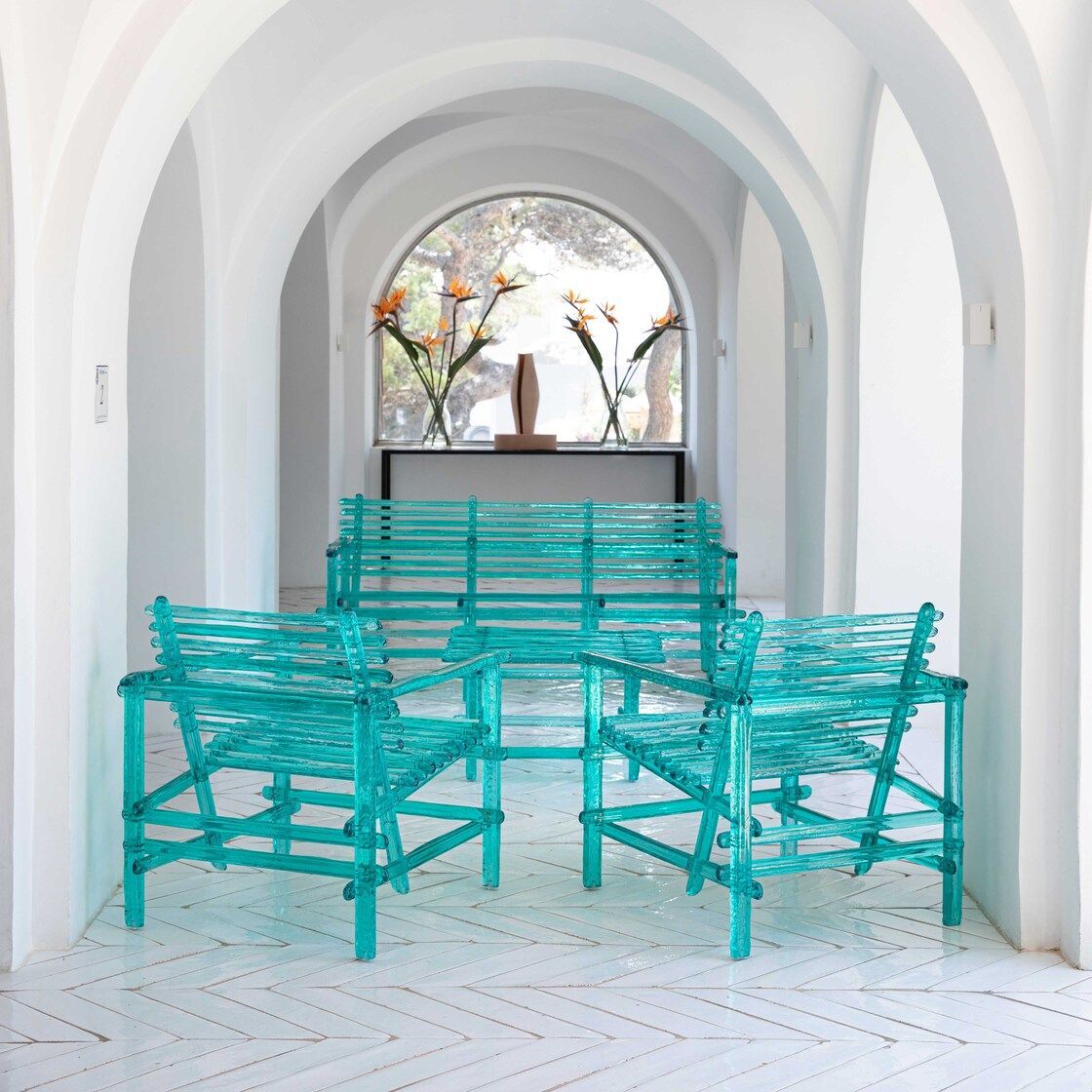
The A’mare Collection stands out on the white Vietri ceramic floor and brings the suggestion of water under the white arcades of the villa.
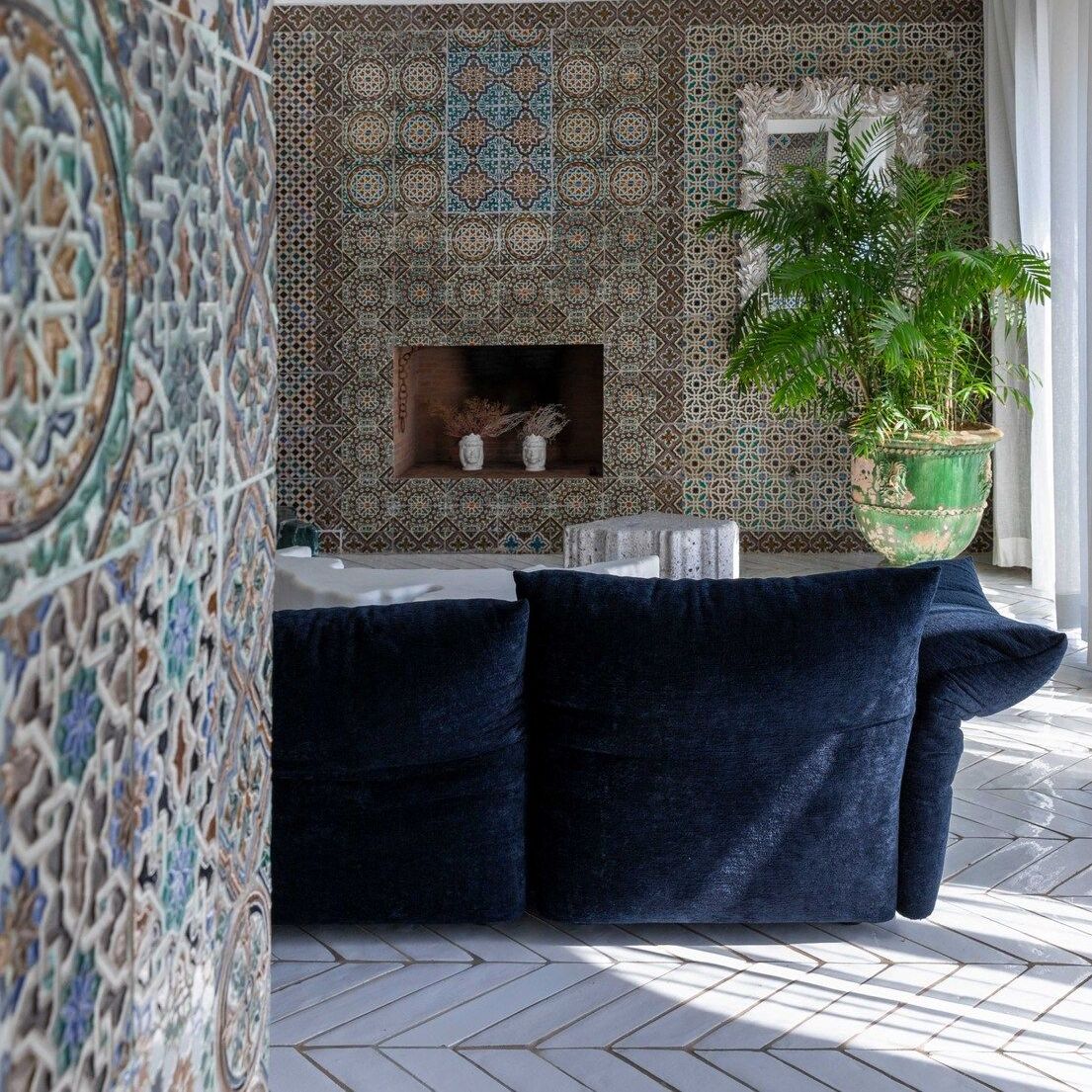
Standard inside one of the rooms of the villa. The colors of the sofa recall the blue tones of the ceramics and wooden doors.
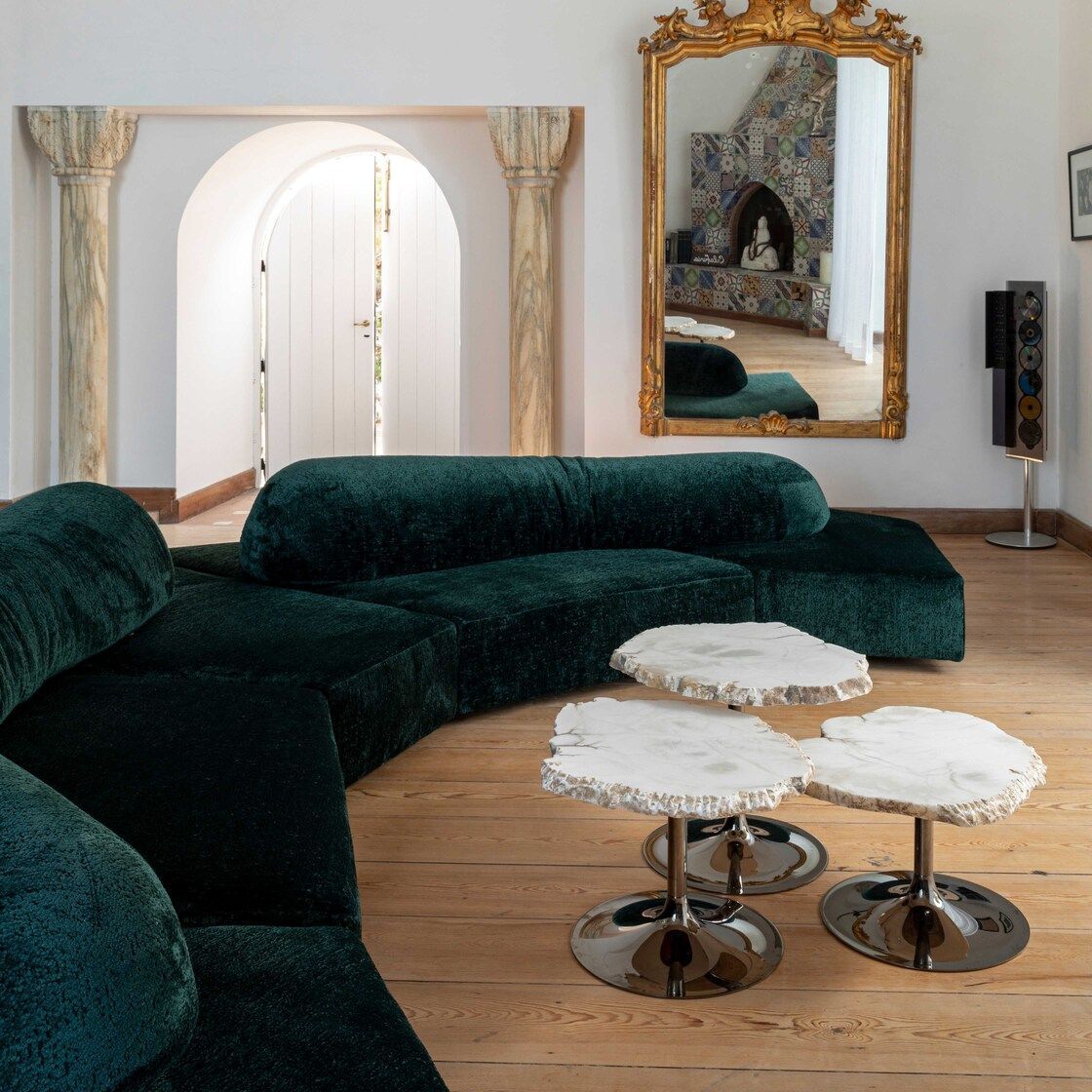
On the Rocks and Cicladi. The sofa by Francesco Binfarè and the alabaster tables by Jacopo Foggini inside the “ballroom” that Léonide Massine had set up in the Saracen tower, where Rudolf Nureyev also danced.
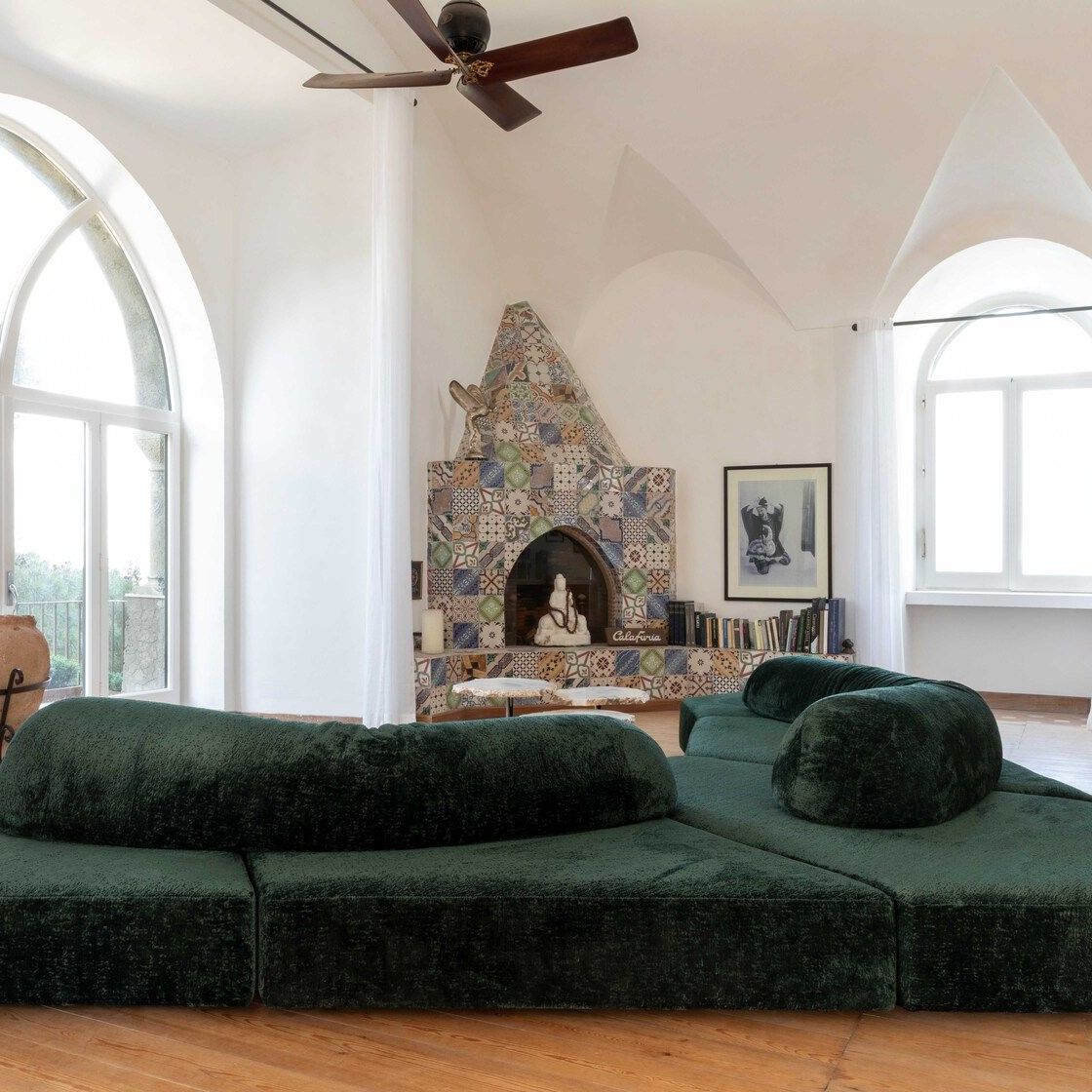
On the Rocks and Cicladi. The sofa by Francesco Binfarè and the alabaster tables by Jacopo Foggini inside the “ballroom” that Léonide Massine had set up in the Saracen tower, where Rudolf Nureyev also danced.
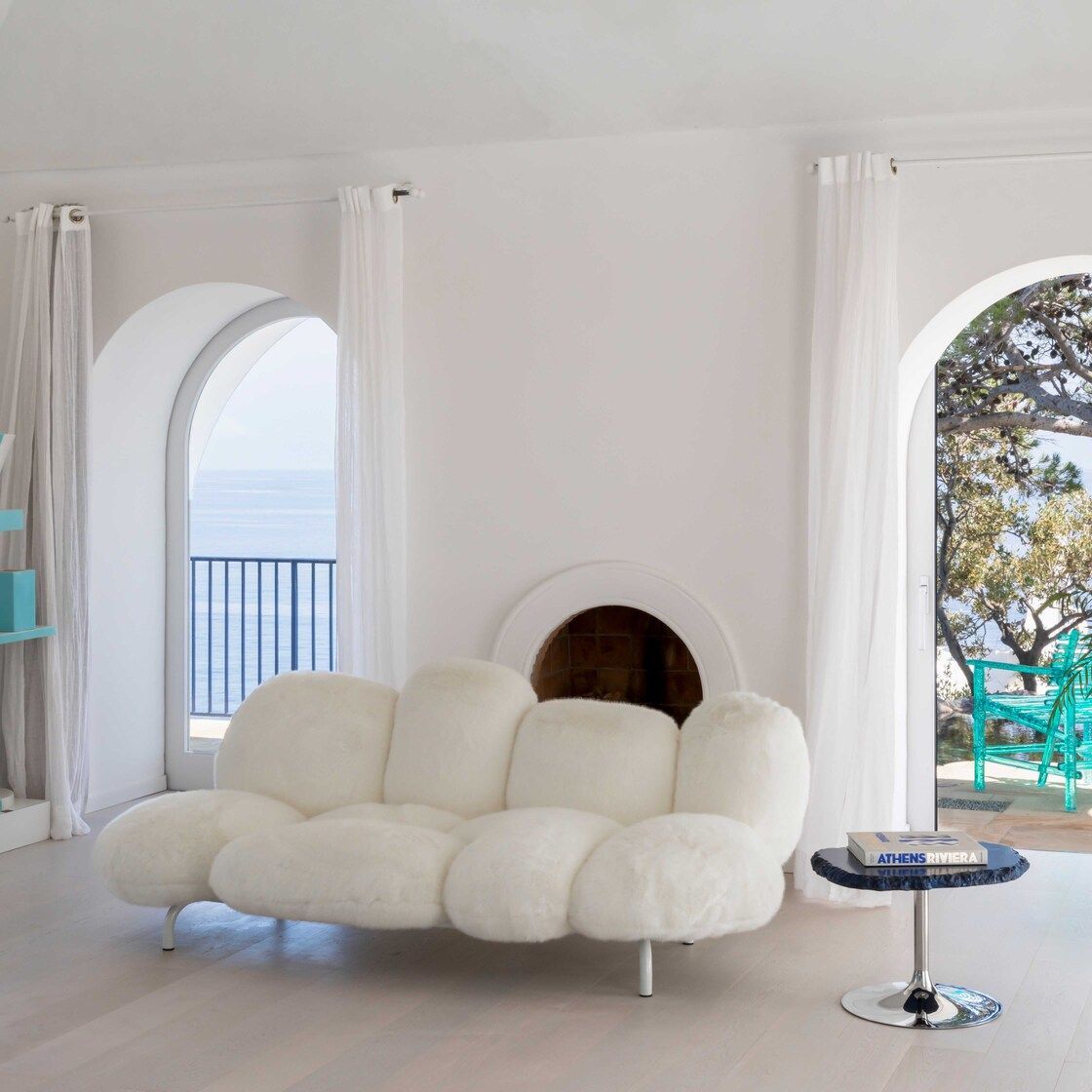
Cipria, Cicladi and A’mare. The sofa by the Campana brothers, the coffee tables and the chair by Jacopo Foggini inside and overlooking the master bedroom. The colors and materials of the furnishings blend in harmony with the architectural and landscape context. On the left the work of Ettore Sottsass Claire de Lune, a ceramic totem in white and turquoise.





